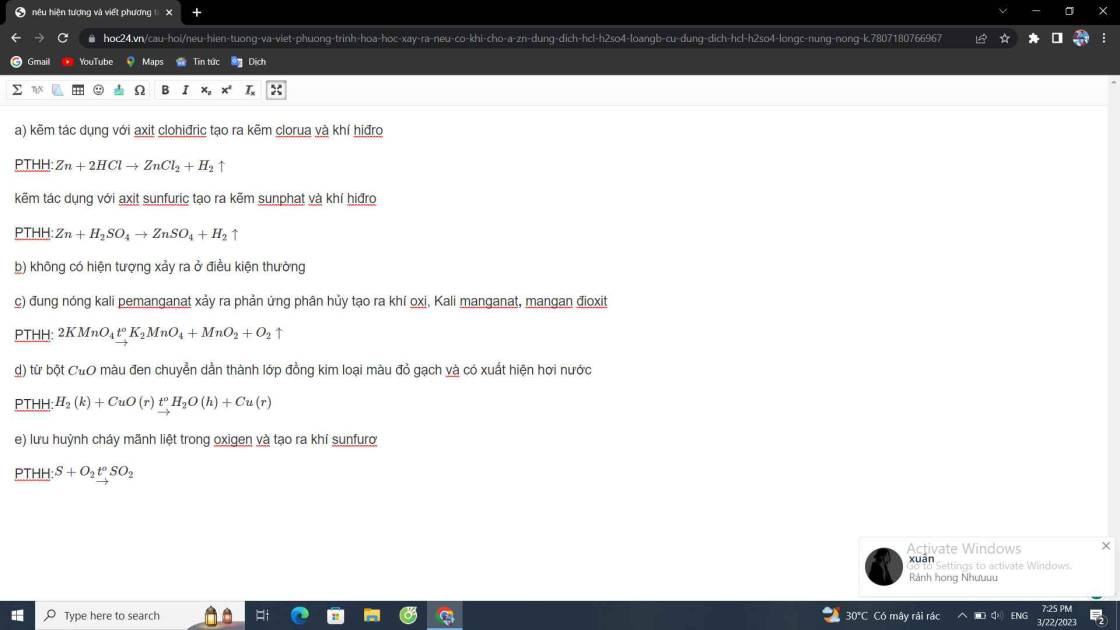Hãy nhập câu hỏi của bạn vào đây, nếu là tài khoản VIP, bạn sẽ được ưu tiên trả lời.


f) trong không khí có khí cacbonic nên tác dụng với lớp vôi trong nước bị đục
PTHH:\(CO_2+Ca\left(OH\right)_2\rightarrow CaCO_3+H_2O\)

\(a.Zn+2HCl\rightarrow ZnCl_2+H_2\\ b.n_{Zn}=\dfrac{65}{65}=1\left(mol\right)\\ n_{ZnCl_2}=n_{Zn}=1\left(mol\right)\\ \Rightarrow m_{ZnCl_2}=1.136=136\left(g\right)\\ c.n_{H_2}=n_{Zn}=1\left(mol\right)\\ \Rightarrow V_{H_2}=1.22,4=22,4\left(l\right)\)

a) nAl=0,2(mol)
PTHH: 2 Al + 6 HCl -> 2 AlCl3 + 3 H2
H2 + CuO -to-> Cu + H2O
nAlCl3= nAl= 0,2(mol)
=> mAlCl3= 133,5. 0,2= 26,7(g)
b) nCu= nH2= 3/2 . 0,2=0,3(mol)
=> mCu= 0,3.64=19,2(g)
(Qua phản ứng nghe kì á, chắc tạo thành chứ ha)
<3

a) 2Al+6HCl→2AlCl3+3H22Al+6HCl→2AlCl3+3H2
b) nAl=5,427=0,2(mol)nAl=5,427=0,2(mol)
Theo phương trình : nH2=32nAl=0,3(mol)nH2=32nAl=0,3(mol)
→VH2(đktc)=0,3.22,4=6,72(l)→VH2(đktc)=0,3.22,4=6,72(l)
c) Chất rắn : 0,2(mol)0,2(mol)
CuO dư : 0,2(mol)Cu0,2(mol)Cu
%CuO=0,2.80(0,2.80+0,2.64).100=55,56%%CuO=0,2.80(0,2.80+0,2.64).100=55,56%
%Cu=44,44%%Cu=44,44%
a)\(n_{Al}=\dfrac{5,4}{27}=0,2mol\)
\(2Al+3H_2SO_4\rightarrow Al_2\left(SO_4\right)_3+3H_2\)
0,2 0,3 0,1 0,3
b)\(V_{H_2}=0,3\cdot22,4=6,72l\)
c)\(n_{CuO}=\dfrac{32}{80}=0,4mol\)
\(CuO+H_2\rightarrow Cu+H_2O\)
0,4 0,3 0,3
\(m_{Cu}=0,3\cdot64=19,2g\)

nAl = 5.4/27 = 0.2 (mol)
2Al + 6HCl => 2AlCl3 + 3H2
0.2.......0.6......................0.3
CM HCl = 0.6 / 0.4 = 1.5 (M)
nCuO = 32/80 = 0.4 (mol)
CuO + H2 -to-> Cu + H2O
0.2.......0.2..........0.2
Chất rắn : 0.2 (mol) CuO dư , 0.2 (mol) Cu
%CuO =\(\dfrac{0,2.80}{0,2.80+0,2.64}\) 100% = 55.56%
%Cu = 44.44%
a) \(2Al+6HCl\rightarrow2AlCl_3+3H_2\)
b) \(n_{Al}=\dfrac{5,4}{27}=0,2\left(mol\right)\)
Theo phương trình : \(n_{H_2}=\dfrac{3}{2}n_{Al}=0,3\left(mol\right)\)
\(\rightarrow V_{H_2}\left(đktc\right)=0,3.22,4=6,72\left(l\right)\)
c) Chất rắn : \(0,2\left(mol\right)\)
CuO dư : \(0,2\left(mol\right)Cu\)
\(\%CuO=\dfrac{0,2.80}{\left(0,2.80+0,2.64\right)}.100=55,56\%\)
\(\%Cu=44,44\%\)

PTHH: \(Fe_xO_y+yH_2\underrightarrow{t^o}xFe+yH_2O\)
\(Fe+2HCl\rightarrow FeCl_2+H_2\uparrow\)
Đặt \(\left\{{}\begin{matrix}n_{Fe\left(oxit\right)}=a\left(mol\right)=n_{H_2}\\n_{O\left(oxit\right)}=b\left(mol\right)\end{matrix}\right.\)
Ta có: \(m_{tăng}=m_{Fe}-m_{H_2}\) \(\Rightarrow56a-2a=3,24\) \(\Rightarrow a=n_{Fe}=0,06\left(mol\right)\)
Hỗn hợp D gồm \(\left\{{}\begin{matrix}n_{CO_2\left(dư\right)}=c\left(mol\right)\\n_{H_2O}=n_{O\left(oxit\right)}=b\left(mol\right)\end{matrix}\right.\)
Ta có hệ phương trình: \(\left\{{}\begin{matrix}c+b=0,1\\18b+2c=7,4\cdot2\cdot\left(b+c\right)\end{matrix}\right.\) \(\Leftrightarrow\left\{{}\begin{matrix}b=0,08\\c=0,02\end{matrix}\right.\)
\(\Rightarrow x:y=a:b=0,06:0,08=3:4\)
\(\Rightarrow\) Công thức cần tìm là Fe3O4
\(K_2O +H_2O \to 2KOH\)
- Hiện tượng : Photpho cháy sáng, có chất rắn màu trắng bắn ra ngoài.
\(4P + 5O_2 \xrightarrow{t^o} 2P_2O_5\)
- Hiện tượng : Có khí không màu không mùi thoát ra. Khi cho qua bột CuO, chất rắn chuyển từ màu đen sang nâu đỏ.
\(Zn + 2HCl \to ZnCl_2 + H_2\\ Fe +2HCl \to FeCl_2 + H_2\\ 2Al + 6HCl \to 2AlCl_3 + 3H_2\\ CuO + H_2 \xrightarrow{t^o} CuO + H_2O\)